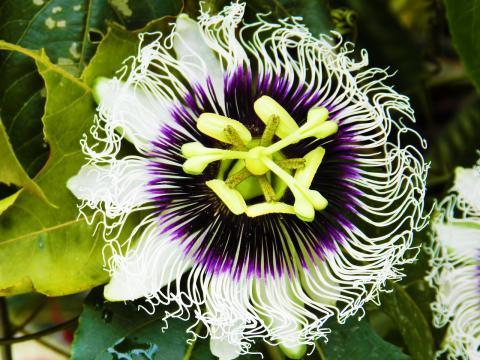
Passion fruit is a member of the family of Passifloraceae in the genus Passiflora and is native to the wild regions of subtropical South America. It was introduced in Hawaii and Australia but succumbed to viruses and could not be sustained as a commercial crop in either region. It does well in South American countries where most of the commercial crops are grown and it does well around the world in the tropical belt. Passion fruit continues to be a popular fruit throughout the world, and in Brazil, juice stands feature the fruit in juices.
Its name was inspired by its distinctive purple flower; the invading Spaniards of the seventeenth century called it the "Flor de las cinco llagas" or "flower of the five wounds." Native Americans used the flowers to heal bruises and wounds, as a sleep aid, and as a relaxing agent; the leaves and root were used in poultices for injuries and boils. It is a versatile fruit that can be prepared in many recipes or eaten as a snack. Passion fruit is highly nutritious, containing vitamins, minerals, antioxidants, and fiber, and it is low in calories.
The passion fruit plant lives five to seven years and grows on a vine that grows fifteen to twenty feet a year, clinging by tendrils to any support. It begins to grow fruit between one and three years. Its evergreen leaves are alternate, deeply three-lobbed at maturity with finely toothed edges that grow from three to eight inches in length. They are a glossy green with a tinge of red or purple on the top surface and pale, dull green on the underside. The fragrant flowers grow from two to three inches in diameter; they are a rich purple at the base that ray to white at the tip. Purple passion fruit is self-pollenating under humid conditions and can be hand pollenated. The fruit is almost round and grows from one-and-one-half to three inches in diameter with smooth, waxy skin that ranges in color from dark purple with faint white specks, pale yellow, or a pumpkin orange. The orange flesh is a juicy pulp that contains up to 250 small, hard, dark brown or black pitted seeds. It has a sweet and tart musky flavor. There are two varieties: purple, which has less acidity, and yellow, which is the larger of the two. The fruit ripens seventy to eighty days after pollination.
Health Benefits of Passion Fruit
1. Passion fruit is rich in nutrients, including vitamins A, C, E, and K. It also contains several B-vitamins like B1 or thiamin, B2 or riboflavin, B3 or niacin, B6 or pyridoxine, and B9 or folates. Passion fruit is also rich in minerals such as sodium, potassium, calcium, copper, iron, magnesium, phosphorus, selenium, and zinc. To add to the nutrient list, we can include the phytonutrients carotene, crypto-xanthin-ß, and lycopene.
2. Passion fruit is a factor in a healthy immune system because of its content of vitamin C, carotene, and crypto-xanthin-ß. These are antioxidant acting substances that remove the free radicals that form in the body before they can do damage. Vitamin C is also a factor in stimulating white blood cells that protect the body from both minor and major illnesses.
3. To prevent the formation of cancers, the antioxidants present in passion fruit remove the free radicals that tend to mutate the DNA of healthy cells, thus changing into cancer cells.
4. Its high vitamin A content makes it an ideal fruit for ocular health, preventing diseases like macular degeneration, cataracts, and night blindness.
5. Passion fruit is highly recommended as a digestive aid due to its fiber content. It helps regulate bowel movements and reduces toxins that form in the colon. Fiber bulks the digested food, giving it a laxative quality and preventing constipation.
6. Passion fruit regulates blood pressure because it is rich in potassium. It relaxes the tension in the blood vessel, resulting in increased blood flow, which reduces the strain on the heart and promotes cardiovascular health. It is also a factor in improving circulation because of the presence of iron and copper. These substances increase the production of red blood cells that oxygenate the body.








